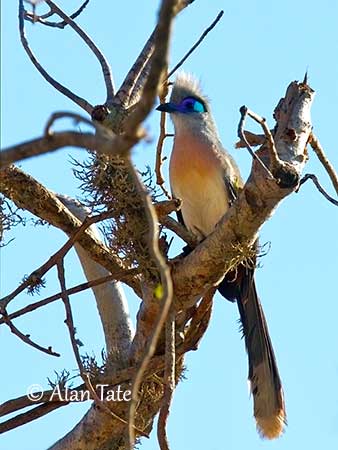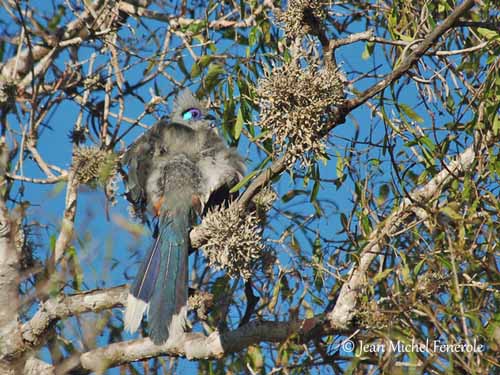
Fr: Coua huppé
Ang: Crested Coua
All: Schopfseidenkuckuck
Esp: Cúa Crestado
Ita: Cua crestato
Nd: Kuifcoua
Sd: tofskoua
Mal: Abosanga, Tivoka, Tokambolo, Tsikokofotsy, Tsiloko, tsipara
Photographers:
John Anderson
John Anderson Photo Galleries
Jean Michel Fenerole
Photos d’Oiseaux du monde
William Price
PBase-tereksandpiper & Flickr William Price
Alan & Ann Tate
AA Bird Photography
Text by Nicole Bouglouan
Sources :
HANDBOOK OF THE BIRDS OF THE WORLD vol 4 by Josep del Hoyo-Andrew Elliott-Jordi Sargatal - Lynx Edicions - ISBN: 8487334229
Wikipedia, the free encyclopaedia
THE AVIANWEB - Beauty of Birds (Sibylle Faye)
Birds of Madagascar: A Photographic Guide Par Pete Morris, Frank Hawkins
Birds of the Indian Ocean Islands Par Ian Sinclair, Olivier Langrand
Crested Coua Bird Photo et information – A rare site in the US
Wild facts – Fun for all Animal Lovers
Pictures and information on Crested Coua – Nancy’s Bird Journal

Crested Coua
Coua cristata
Cuculiformes Order – Cuculidae Family
INTRODUCTION:
The Crested Coua is endemic to Madagascar where it occurs from sea-level to 1000 metres of elevation in forest, savanna and brushland.
This species is mainly terrestrial and arboreal, walking along branches and using its long tail for balance. It only flies over short distances or from the ground to a tree.
The Crested Coua is widespread and locally common throughout the range. It is vulnerable to hunting pressure and forest fragmentation, but it occurs in several protected areas such as reserves and national parks. It is not currently threatened.
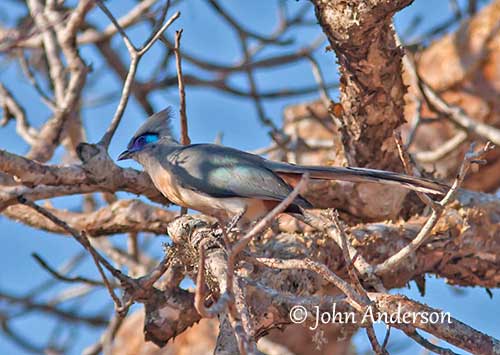
DESCRIPTION OF THE BIRD:
Biometrics:
Length: 40-44 cm
Weight: 103-105 g
The Crested Coua adult has greenish-grey upperparts and grey head with conspicuous pointed crest. The long graduated tail is bluish with white tips.
On the underparts, chin and throat are grey. The breast is pale orangey/rufous and the belly is white.
On the head, the bare skin around the eye is lilac with black outlining, but the skin is bright turquoise behind the eye. The grey crest is slightly shaggy and pointed.
The bill is black. The eyes are reddish-brown. Legs and feet are black and the third toe can be reversed for better grip.
Male and female are similar.
The juvenile has grey crown, rufous-edged feathers to back and wing-coverts. The skin of the face is feathered. The bill is pale grey with pink base.
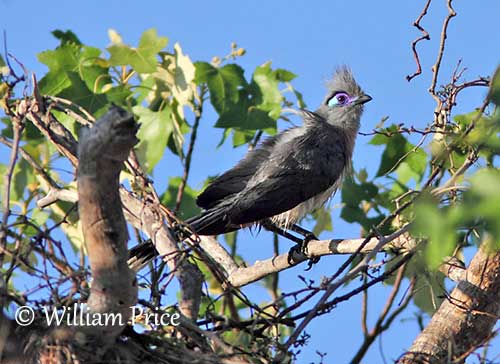
CALLS AND SONGS: SOUNDS BY XENO-CANTO
The Crested Coua is mainly vocal before sunset. It gives loud, descending “guay-guay-guay-guay-gwuck” and often several birds call together and respond to each other’s, creating a melodious twilight chorus.
We can also hear a loud “guilp” and a low cooing in contact. When the bird is alarmed, it produces a chicken-like clucking “wuk-wuk-wuk”.
BEHAVIOUR IN THE WILD:
The Crested Coua feeds primarily on large insects, but it also consumes fruits and small reptiles. Insects include crickets, mantises, grasshoppers, beetles, cicadas and caterpillars. But it also takes snails, chameleons, geckos, and some plant matter such as seeds, fruits and berries. It may sometimes take eggs of other bird species, and it also gets food items from the ground.
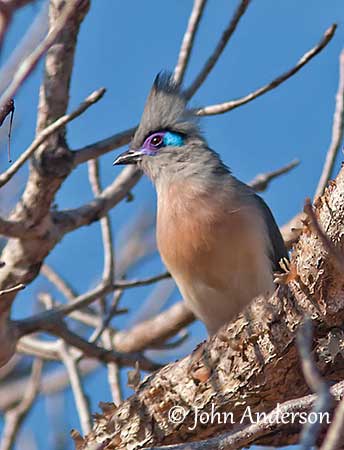
The Crested Coua builds its own nest and does not parasitize the nests of other bird species. Both adults share the nesting duties.
It is resident in Madagascar.
This species is mainly terrestrial and arboreal, but it performs long glides from tree to tree while foraging.
REPRODUCTION OF THIS SPECIES:
The breeding season takes place between mid-September and mid-March. Both mates build the nest, a bulky bowl made with twigs and rootlets, about 2-5 metres above the ground, usually in tree such as Tamarindus indica.
The female lays 2-3 white eggs. Both parents share the incubation but duration is unknown in the wild. However, captive birds incubate during two weeks, and this period is probably longer in the wild.
At hatching, the chicks are naked. They have dark skin and the bill is reddish. They have conspicuous markings inside the mouth, used by parents for identification or to help in feeding. The young leave the nest 10 days after hatching and they are probably fed by the adults for some days more.
PROTECTION / THREATS / STATUS:
The Crested Coua is still present in degraded forests in spite of heavy hunting pressure. It is widespread throughout the range, and even locally common. It is present in protected areas such as reserves and national parks.
The size of the population is unknown, but it is suspected to be declining due to habitat loss and hunting pressure.
But currently, the Crested Coua is evaluated as Least Concern.
SUBSPECIES AND RANGE:
The Crested Coua has four subspecies.
C.c. cristata (described above) is found in N and E Madagascar (SW to Mahajanga).
C.c. dumonti occurs in W Madagascar, from Mahajanga S to Morondava.
This race is larger with longer wings. The breast is paler with less extensive rufous but there is little rufous on the undertail-coverts. The white tail tips are broader and the crest is longer.
C.c. pyropyga occurs in W Madagascar, between Morondava and Toliara, and S to Amboasary.
This one is larger and paler, with bright rufous undertail-coverts and broad white tail tips.
C.c. maxima is found in SE Madagascar (near Tolagnaro).
This race is the largest and the darkest of all races. The upperparts are greyish-blue with violet-blue uppertail. The throat is greyish-blue. The tawny-brown colour of the breast extends to the vent. On the upperwing, flight-feathers and tertials are glossy blue. This race is rare or even extinct.
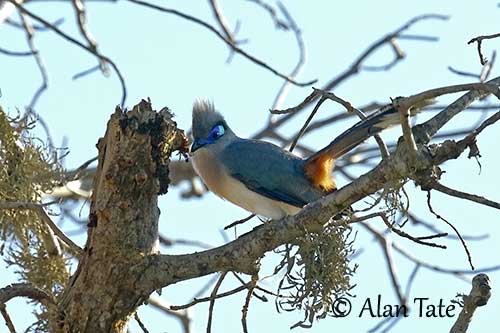
It forages at higher levels of forest, and moves from tree to tree with a long glide. It gleans food from branches and trunks, moving from the base to the top and repeating the process.
The Crested Coua is secretive and usually found alone or in pairs. However, outside the breeding season, they form small groups of 3-5 individuals and often join mixed-species flocks.
The courtship behaviour is poorly known, but we can suggest that the bright-coloured head pattern, the crest and the long, graduated, tipped-white tail are enhanced by adapted postures. Courtship feeding by male to female is reported, accompanied by quiet “grr…grr…grr…”
